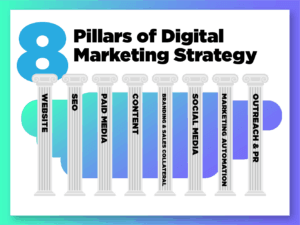How to Implement Strategy in Digital Marketing
Much like any successful business, killer digital marketing campaigns are not created overnight. As a business leader, you spend too many sleepless nights outlining plans and ideas, and several grueling months in the trial and error stage. By the time you’re ready to launch your new brand, you may be a dangerous combination of excited and exhausted. It’s a combination that might lead you to make some ill-advised, quick decisions. You may jump at the first offer to run an ad or get your website up and running. However, this is a crucial time to slow down, refocus, and harness the patience that has gotten you this far. Your digital marketing plan outlines the way you are going to tell the world about the incredible product or service that you have worked so hard to create. It’s your chance to tell your story, hook lifelong customers, and of course, make some money! It deserves the same amount of time and attention to detail as it took to start your business in the first place.
When it comes to launching your brand, Abraham Lincoln said it best: “Give me six hours to chop down a tree and I will spend the first four sharpening the axe.” When you set out to build your digital marketing strategy, take the time to implement a comprehensive, individualized plan before any pages or ads are published. The following steps can help get you started:
1. Conduct an Assessment. This is the phase you should spend the most time on. You’ll want to find out what the playing field looks like before you join the game. During your assessment, consider these important aspects of your company:
Your digital marketing plan outlines the way you are going to tell the world about the incredible product or service that you have worked so hard to create. It’s your chance to tell your story, hook lifelong customers, and of course, make some money! It deserves the same amount of time and attention to detail as it took to start your business in the first place.
When it comes to launching your brand, Abraham Lincoln said it best: “Give me six hours to chop down a tree and I will spend the first four sharpening the axe.” When you set out to build your digital marketing strategy, take the time to implement a comprehensive, individualized plan before any pages or ads are published. The following steps can help get you started:
1. Conduct an Assessment. This is the phase you should spend the most time on. You’ll want to find out what the playing field looks like before you join the game. During your assessment, consider these important aspects of your company:
- Industry and market. What’s going on in the market? Is it doing well? How big is it?
- Competition. Who are you directly going up against for clients or customers? Are they doing well? What are they doing the same, and what are they doing differently?
- History. Have you been doing this for a long time? Are you brand-new to the industry?
- Trends and lessons. What have you already learned and noticed? What worked well, and what didn’t work at all?
- Strengths, weaknesses, opportunities, and threats (SWOT). Evaluate what your business does well and how to capitalize on that, as well as what your business could do better and how that weak spot may hurt you.
- Audience. Who are you trying to reach? Who are your potential customers or clients?
- Demographics: Age, race, gender, annual household income, etc.
- Psychographics: Your customers’ interests, activities, and opinions.
- Media consumption: How much and which types of media does your target audience consume?
a. Objectives — Where Do We Need to Go?
Once you assess where you stand in the playing field, it’s time to set objectives, or where you need or want to go from there. An objective is a broad goal meant to propel your business forward. It sets purpose and direction, and keeps you and your employees inspired. Everyone can be assured that their work has meaning when they understand the common goal that they are working together to achieve.
That being said, it is possible to set the wrong kinds of goals or objectives. John Doerr is a venture capitalist who worked with Andy Grove. In his TED Talk on OKRs, Doerr said it’s all about setting the right goals for the right reasons. You can set a goal of making a certain amount of money, but will that really inspire your team? It might if you’re making the money for a good cause, but it might not if the profits only benefit the CEO.
According to Doerr, it’s important to have a compelling sense of why the objective exists. If your team believes in the mission, they are more likely to embrace the work, and do everything they can to keep moving toward your goals.
In the marketing world, a common objective is improving overall quantity and quality of leads. It’s okay to be that broad; the specifics will come later. When Sundar Pichai became Google’s new CEO in 2016, he set a three-year objective to “build the next-generation client platform for the future of web application,” or to build the best browser. How he measured that was up to him, which brings us to the “KR” part of the framework.
b. Key Results — How Do We Know We’re Getting There?
Key results are how you measure the progress toward your objectives. They should be metrics that show you exactly how close you are to meeting your objective. According to Doerr, key results should be:
- Specific and time-bound.
- Aggressive yet realistic.
- Measurable and verifiable.
Key results within a digital marketing plan may include generating a specific number of leads, increasing organic traffic by a set percentage, or achieving a certain return on advertising spend (ROAS). All of these measurable key results will be set with your objectives in mind.
For Google Chrome, Pichai chose to use the number of users to determine how close he was to building the best web browser. He set a first-year goal of 20 million users, a second-year goal of 50 million, and a third-year goal of 100 million. In year one, Google had less than 10 million users. Instead of lowering his key results, Pichai continued to strive for his original numbers. In the second year, he had 37 million users. He continued improving the technology and launched an aggressive marketing campaign, and by the third year, he passed his goal and Google Chrome had 111 million users.
The positive results didn’t come immediately, but Pichai was persistent and focused on his objective. He chose an objective he was so passionate about that he was not deterred when he didn’t achieve his key results during the first two years. He set the right goal for the right reasons, and to get over the hump the third year, he adjusted another part of the OKR strategy: the initiatives.
c. Determine Your Initiatives.
Within the OKR framework, initiatives describe the work required in order to accomplish the key results. They make you ask “what are you going to do to achieve your goals?”
With Google Chrome, aggressive marketing and technological improvements were some of the initiatives that helped Pichai get more users, achieving his key results and getting closer to his objective.
At Avalaunch Media, one of our main objectives is to build a sustainable lead generation model that consistently produces high-quality business prospects. Our key results include set numbers of website traffic and monthly qualified leads (MQLs).
In order to achieve our key results, we use a detailed quarterly playbook with all of our clients. It lays out all the services we offer, and outlines how many hours we want to dedicate to each one. In order to streamline the way we create each digital marketing plan, we’ve developed categories that we call “the eight pillars of digital marketing:” The pillars are: Website, Search Engine Optimization (SEO), Paid Media, Content, Branding & Sales Collateral, Social Media, Marketing Automation, Outreach & Public Relations
The pillars are: Website, Search Engine Optimization (SEO), Paid Media, Content, Branding & Sales Collateral, Social Media, Marketing Automation, Outreach & Public Relations
The pillars you choose to put emphasis on make up your initiatives. Maybe you need to implement all eight pillars, but put extra emphasis on social media and SEO. By setting your objectives and key results first, you’ve made outlining your initiatives much simpler. Having your OKRs as a guide will help determine which of the pillars are most important to your custom digital marketing plan.
Without a comprehensive strategy, you may end up spending unnecessary time and money. Think about what may have become of Google Chrome if Pichai had not set specific goals and measurable key results. He may have said he wanted to create a successful browser, but without his goal of 100 million users, he could have spent years deciding what “successful” truly meant, not knowing which initiatives to focus on to get there.
It’s important to remember that your digital marketing plan is a living, working document. You can always make changes, adjust your priorities, and implement new initiatives. As long as you continue setting meaningful objectives that keep you and your team motivated, your work will have meaning, and success will stay in your reach.